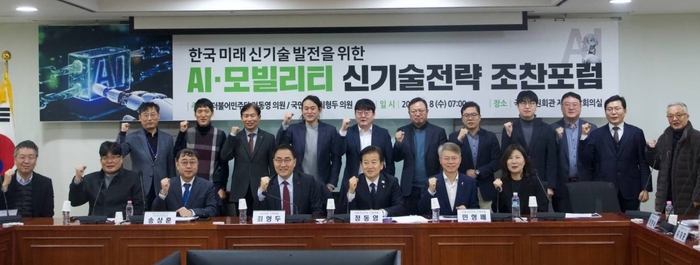
On the morning of the 8th, the 9th discussion session of the 'AI·Mobility New Technology Strategy Breakfast Forum' co-hosted by Democratic Party of Korea member Chung Dong-young and People Power Party member Choi Hyung-doo of the National Assembly Science, Technology, Information, Broadcasting and Communications Committee and organized by the National IT Industry Promotion Agency (hereinafter referred to as 'NIPA') was held in the 9th discussion room of the National Assembly Members' Hall.
Rep. Jeong Dong-young listened to the presentation by Baek Jun-ho, CEO of Furiosa AI, titled “AI Semiconductors and Fabless: Competition in the Global Battleground,” and noted the importance of “AI Semiconductors and Fabless.”
CEO Baek emphasized that “AI chips are the fundamental technology that determines the competitiveness of the AI industry.” He also explained that AI semiconductors account for 40% of the entire AI value chain, and that efficient ‘microarchitecture’ design is a key task in AI semiconductor development. Furiosa AI introduced that it is conducting performance tests of the AI chip ‘Renegade’ with excellent domestic and foreign companies such as LG AI Research Institute and Saudi Arabian Aramco in order to block the monopoly of American semiconductor company NVIDIA.
Song Sang-hoon, director of the Ministry of Science and ICT’s Information and Communication Policy Bureau, defined AI semiconductors as “not simple hardware, but an essential basic technology in the data economy era,” and explained, “In order for companies developing and designing AI and semiconductors to grow, we need to build a system that integrates the entire process of AI chip design, packaging, and manufacturing.”
KAIST Vice President Kim Kyung-soo stated, “We need to foster specialized personnel with capabilities in AI semiconductor development, including microarchitecture design and software optimization,” and proposed introducing practical education centered on industry-academia cooperation and global education programs.
Park Du-seon, a professor at Sungkyunkwan University, suggested that “universities should systematize talent development by integrating AI education courses with other majors or establishing new departments.” He also mentioned that cooperation with industry should be specific and that the government should actively create a cooperation model through programs that connect industry and academia.
Kim Deuk-joong, Vice President of NIPA, asserted that not only nurturing talent but also ‘securing talent’ is an important task for the AI semiconductor industry. Vice President Kim added that measures should be taken to prevent domestic high-level talent from leaving the country, and an environment should be created for foreign talent to enter the country.
Jung-Woo Ha, Director of Naver Cloud Center, pointed out the limitations of benchmarks as a realistic challenge for AI semiconductors and suggested the introduction of new, realistic performance evaluation indicators based on multi-batch processing and energy efficiency of generative AI.
Jaesik Choi, chairman of the National Coalition for a Just Science and Technology Society, emphasized that AI semiconductors should go beyond simple hardware and integrate software, algorithms, and data processing technology. In particular, he mentioned the importance of multimodal AI technology, and argued that AI semiconductor designs that can efficiently process various data formats such as text, images, and videos are necessary.
In addition, Chairman Choi emphasized that “in order for AI semiconductors to be globally competitive, technologies that expand memory bandwidth and improve power efficiency are essential,” and suggested that domestic companies focus on cooperation and innovation to achieve this.







